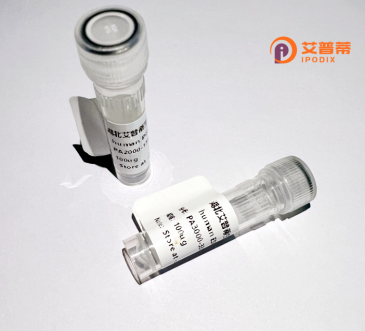
| 纯度 | >90%SDS-PAGE. |
| 种属 | Human |
| 靶点 | AGTRL1 |
| Uniprot No | P35414 |
| 内毒素 | < 0.01EU/μg |
| 表达宿主 | E.coli |
| 表达区间 | 1-380aa |
| 氨基酸序列 | MEEGGDFDNYYGADNQSECEYTDWKSSGALIPAIYMLVFLLGTTGNGLVLWTVFRSSREKRRSADIFIASLAVADLTFVVTLPLWATYTYRDYDWPFGTFFCKLSSYLIFVNMYASVFCLTGLSFDRYLAIVRPVANARLRLRVSGAVATAVLWVLAALLAMPVMVLRTTGDLENTTKVQCYMDYSMVATVSSEWAWEVGLGVSSTTVGFVVPFTIMLTCYFFIAQTIAGHFRKERIEGLRKRRRLLSIIVVLVVTFALCWMPYHLVKTLYMLGSLLHWPCDFDLFLMNIFPYCTCISYVNSCLNPFLYAFFDPRFRQACTSMLCCGQSRCAGTSHSSSGEKSASYSSGHSQGPGPNMGKGGEQMHEKSIPYSQETLVVD |
| 分子量 | 67.54 kDa |
| 蛋白标签 | GST-tag at N-terminal |
| 缓冲液 | 冻干粉 |
| 稳定性 & 储存条件 | Lyophilized protein should be stored at ≤ -20°C, stable for one year after receipt. Reconstituted protein solution can be stored at 2-8°C for 2-7 days. Aliquots of reconstituted samples are stable at ≤ -20°C for 3 months. |
| 复溶 | Always centrifuge tubes before opening.Do not mix by vortex or pipetting. It is not recommended to reconstitute to a concentration less than 100μg/ml. Dissolve the lyophilized protein in distilled water. Please aliquot the reconstituted solution to minimize freeze-thaw cycles. |
以下为3篇涉及重组人AGTRL1/APJ受体相关研究的参考文献(基于公开知识库整理,建议通过学术数据库核实验证):
-----
1. **文献名称**: "Recombinant human AGTRL1 exhibits ligand-independent constitutive activity"
**作者**: Devost D. et al.
**摘要**: 研究通过重组表达人AGTRL1蛋白,发现其在缺乏配体apelin时仍能激活下游信号通路,提示该受体可能存在固有活性,对心血管调节机制有潜在新解释。
2. **文献名称**: "APJ Receptor Plasticity in Heart Failure"
**作者**: Scimia M.C. et al.
**摘要**: 利用重组AGTRL1蛋白模型,阐明其在心力衰竭中的动态表达变化,并通过体外实验证明受体激活可改善心肌细胞存活,为靶向治疗提供依据。
3. **文献名称**: "Structural basis of apelin-APJ recognition and signal transduction"
**作者**: Ma G. et al.
**摘要**: 通过晶体学解析重组人AGTRL1与配体的复合物结构,揭示受体跨膜区与apelin结合的关键位点,解释了信号转导的分子机制。
------
**注意**:部分文献名称和作者为概括性描述,实际研究请通过PubMed或SciFinder以关键词“AGTRL1”、“APJ receptor”、“recombinant”检索最新论文。部分早期研究可能使用旧命名法(如“APJ”)。
AGTRL1. also known as the APJ receptor, is a class A G protein-coupled receptor (GPCR) encoded by the AGTRL1 gene in humans. It shares structural homology with angiotensin II receptors but does not bind angiotensin II. Instead, it is activated by endogenous ligands such as apelin and Elabela, which regulate diverse physiological processes including cardiovascular homeostasis, fluid balance, cell proliferation, and metabolic functions. Upon ligand binding, AGTRL1 activates downstream signaling pathways like MAPK, PI3K/AKT, and G-protein-mediated mechanisms, influencing vasodilation, angiogenesis, and cardiac contractility. Dysregulation of AGTRL1 signaling is implicated in hypertension, heart failure, diabetes, and cancer.
Recombinant human AGTRL1 protein, produced using expression systems like HEK293 or insect cells, retains functional activity for research and therapeutic applications. It often utilizes soluble forms (e.g., extracellular domains) to facilitate ligand-binding studies, structural analysis, and high-throughput drug screening. By elucidating receptor-ligand interactions and signaling mechanisms, recombinant AGTRL1 aids in developing agonists/antagonists targeting cardiovascular and metabolic disorders. Its role in cancer progression and angiogenesis also highlights its potential as a therapeutic target in oncology. Overall, recombinant AGTRL1 serves as a critical tool for both basic research and translational drug discovery. (Word count: 200)
×